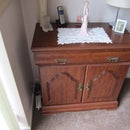Introduction: Repairing a Damaged Tumble Dryer Rear Bush Housing
some years ago I did an instructable on how to renew the rear bush on my White Knight 44 tumble dryer due to annoying squeak.Recently it started to make a banging noise and we at first thought it was over/uneven loading and put it off (as you do)but it got worse until even with the music turned up full it was obvious there was something drastically amiss. Anyway as one of the commentators on the original thread had mentioned a similar banging I assumed it was the same thing that one of the rivets had sheared and removed the back. While the rivets were loose they were intact what was obvious was that the bush has badly worn .
So I ordered up a bush kit -now £8
Step 1: Damaged Bush Housing
when the kit came and i started the strip down it became obvious there were actually 2 problems
1/the bush had worn away and allowed the steel shaft to rub against the alloy housing and the metal to metal contact had worn the housing away, see the new black bush and in the other picture what was left of the old one (ringed in black)!
2/the 3 rivets holding the alloy housing were loose.
on trying the new bush for size I found that the housing was so badly worn that to be honest a new bush wasn't going to fit properly so there was 2 choices
A/ A new drum as the housing doesn't come separately
B/ Attempt a repair
As there was nothing to lose but time at this point i decided to attempt the repair,basically it boiled down to getting a spacer to fit between the alloy housing and the bush to take up the slack and new rivets for the housing.
When I took the covers off, removed the drum (unhook the drive belt and it just pulls out of the front wear pads)and started to hoover out the inside I found a white plastic moon shaped clip. and looking round the inside I found the clip was one of three wear pads around the front opening.The drum rotates on the rear bush but the front is taken care of by 3 of these pads.Fortunately the pad fitted back in fine,I think the violent banging had caused it to jump out .
Step 2: Adapting the Spacer
looking around in my spares box I came across a round thin metal bush and while it fitted over the bush it was to big to fit into the housing so I utilized the old trick of grinding it down externally by fitting it onto the head of a 12mm bolt in my cordless drill and rotating it against my(running) grinder,this gives a rough cylindrical grinding effect,this is trial and error job to remove just enough so it will fit tightly in the housing but allow the shaft to fit in its middle. In-fairness it doesn't have to be metal ,plastic will do as all it needs is to make sure the bush fits tightly into the housing,the bush stays still inside the housing but it rotates around the shaft.Anyhow after a few goes the bush was near but the housing wasn't worn a perfect round shape so I used a carbide bit in my drill to get it nearer to round.
Step 3: Fitting the Spacer
when the metal bush got close enough to start fitting into the housing i decided to push it in,i did this with a pair of water pump pliers to force it into place a bit at a time-one jaw under the housing and one jaw on the metal bush using the long levers to force it in,the results weren't pretty but was effective and the metal bush fitted in,next was the new plastic bush using the same method which fitted it but deformed the internal shaft hole slightly so i used the carbide bit to open it out.I then drilled out the 3 housing holding loose rivets and re-riveted.This is were you need either a assistant or long arms and if i'd have thought i would have installed the bush kit as I bet its a lot easier off than on but...
Step 4: Fitting the Bush Kit &
next was fitting the rest of the kit and while i cover it in my original instructable,its fiddly especially on your own but basically you fit the shaft into the new bush(using the supplied grease first) then put on the rear plastic washer and metal washer with the holding pin (after fitting,cover the head in the grease supplied to give a good electrical contact)which you have to tighten from inside the drum while holding the triangle plate to stop it turning.Next is the copper coloured strip/finger which has to have a pin and washer inserted and again tightened from inside the drum(this is an earthing strip to discharge static generated during the tumble drying.At this point i put all the covers back on and gave myself a pat on the back ...oh whats this black rubber thing...oh that would be the belt that turns the drum....hmmm take the rear cover back off pull the drum away from the front and slip the belt down and under the drum refit the back cover stretch the belt over the motor pulley.Button up the bottom cover and test and ...back to its quiet(ish) operation.how long this repair will last I don't know but id expect it to extend the dryers life by a few years.
P.S dont forget to put kitchen towel into the gap between the outer and inner drum











